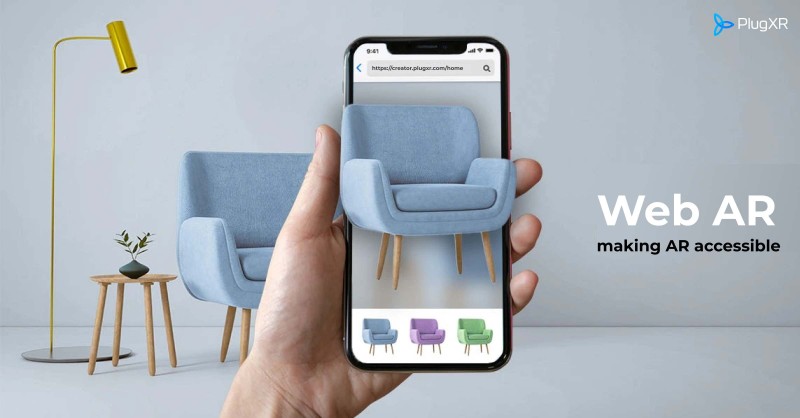Introduction
The world of enhanced reality (AR) is developing at a rapid pace. As we enter 2025, AR technology is ready to redefine industries and increase the way you interact with the world. From entertainment to education, from healthcare, AR is opening new possibilities for businesses, consumers, and developers. In this blog post, we will find out the current status of AR development, the major trends shaping the industry in 2025, the challenges with it, and how platforms like plugxR are helping bring their AR vision to life.
What is Augmented Reality (AR)?
Augmented Reality (AR) is a technique that overlays digital materials - such as images, videos, or sounds - in the real world. Unlike virtual reality (VR), which creates a perfectly immersive experience, AR enhances the real world by adding layers of information that users can interact with through devices such as smartphones, tablets, and AR glasses. AR aims to enrich the user environment by providing an interactive experience in real-time.
As the demand for AR experiences increases, developers face both opportunities and challenges. By 2025, AR is expected to play a central role in consumer engagement, learning, and business operations.
The Trend in 2025 enhanced reality development
1. Integration with 5G network
One of the most important developments for AR in 2025 is integration with 5G technology. The high-speed and low-opacity capabilities of the 5G network will allow AR applications to provide a smooth, rapid, and more reliable experience. The increased bandwidth will support real-time data transfer, allowing more complex and interactive AR applications.
For example, imagine using an AR app, running in a retail store, and getting detailed information about products in real-time, without experiencing any interval or delay. 5G will ensure that these experiences are comfortable, rapid, and more emergent AR-operated retail environments, tourism experiences, and beyond.
2. Learning AI and Machines in AR
Artificial Intelligence (AI) and machine learning will be integrated into AR to make experiences smarter and more comfortable. AI can analyze user behavior and preferences to adopt the AR environment to meet individual requirements. This can mean an AR system that not only provides information but also guesses what the user wants and individual suggestions.
In healthcare, for example, analyzing AR medical data run by AI and overlaying relevant information during surgery can help doctors with real-time diagnosis. In education, AR equipment students can track engagement and adjust the text accordingly, which can ensure a more personal learning experience.
3. AR goggles and wearer extended
While smartphones and tablets are currently primary tools for AR experiences, AR's future lies in wearable technology. In 2025, AR glass and headset will become more advanced, lighter, and more comfortable. These devices will provide a hands-free, immersive AR experience, which makes them perfect for industries such as logistics, manufacturing, and fieldwork, where employees need to use information while keeping their hands free.
Companies like Apple, Microsoft, and Google are already investing heavily in AR glasses, and by 2025, we can expect these devices to be available to the mainstream consumer, which is more immersive to experience AR And provide efficient methods.
4. AR in e-commerce
In the purview of e-commerce, AR is already having a significant impact, and this trend will be strong only by 2025. Virtual tri-on and product visualization will become standard features for online shopping experiences. Consumers will be able to "try" on clothes, accessories, and makeup before shopping, and will preview how the furniture and home decoration items will look in their living places.
With the integration of AI and better AR technology, e-commerce businesses will be able to provide excessive personal purchasing experiences, increase customer satisfaction, and increase conversion rates.
5. Spatial computing and virtual cooperation
Spatial computing-AR using AR is another trend set to close and manipulate the ability to interact with the atmosphere by -2025. This will change cooperation, allowing remote teams to interact in shared AR space, and making virtual meetings feel like in-tradition interactions. , This is particularly useful for industries where visual cooperation is important, such as architecture, engineering, and design.
By 2025, remote work will probably be more interactive, in which cooperation with employees and teams will have to cooperate in virtual AR locations. This will be smooth by both AR hardware and software, providing equipment in real-time to engage in virtual churning, design reviews, and problem-solution sessions.
Challenges in Augmented Reality development
Despite its ability, Augmented Reality development faces many challenges that need to be addressed in the coming years:
1. Hardware limits
Although AR software is improving rapidly, there are still limitations of hardware required to support these experiences. Current AR glass and headsets are often heavy, expensive,e and limited in battery life. Unless the hardware is adapted to adoption on a large scale, more inexpensive, and long-lasting can obstruct the widespread use of AR technology.
2. User Experience (UX) Design
It is a challenge to create an easy and user-friendly AR experience. Developers need to ensure that the AR app and tool are easy to use and users should not be overwhelmed with information. UX design needs to take into account factors such as accessibility, and interaction paradigms and must ensure that the technique grows rather than distracting from the real world.
3. Privacy and security
As the AR application collects real-time data about the environment and behaviors of users, privacy and security become major concerns. Developers will need to ensure how to store and protect sensitive data so that the users feel confident in using AR technology without compromising their personal information.
4. Content creation
Another challenge is the manufacture of high-quality AR materials. Whether it is a digital object, a virtual environment, or an interactive element, AR material is resource-intensive. Businesses need to invest in the right equipment,
PlugXR platform role in AR development
In front of these challenges, platforms such as PlugXR are making AR applications easier for businesses and developers to create and deploy. PlugXR is a no-code AR development platform, designed to simplify the process of manufacturing and publication of AR experiences without the need for intensive programming knowledge.
Major features of PlugXR:
No-Code Development: PlugXR allows users to create an immersive AR experience without any coding. This feature provides democratization of AR development, enabling exposure, designers, and business owners to bring their AR vision to life without relying on a technical team
Cross-Platform Compatibility: PlugXR provides the ability to create an AR experience that works on many devices including smartphones, tablets, and AR headsets. This flexibility makes it easier for businesses to reach wide audiences.
Real-Time Analytics: PlugXR provides real-time insights on how users interact with AR content and helps businesses adapt their experiences for better engagement.
Enterprise Solutions: PlugXR provides an analogous solution for industries such as retail, education, and marketing, which enables businesses to create branded, interactive AR campaigns that run engagement and sales.
As we move into 2025, platforms such as PlugXR will be at the forefront of empowering businesses to create experiences that are both attractive and scalable.
Conclusion
As we look at 2025, the enhanced reality is ready to replace industries and everyday experiences in ways we can only begin to imagine. Integration of AR with 5G, AI, Wearables, and spatial computing will unlock new possibilities for consumers and businesses. However, the challenges related to hardware, UX design, privacy, and material construction will need to be addressed widely.
In this dynamic landscape, platforms such as PlugXR are playing an important role in simplifying AR development, which can enable businesses to create innovative and attractive AR experiences without the need for complex coding. By taking advantage of AR's power, business customers can improve engagement, increase sales, and create memorable experiences that echo with their audience.
With the rapid progress of AR technology, the future is bright, and the possibilities for development and innovation are endless.


